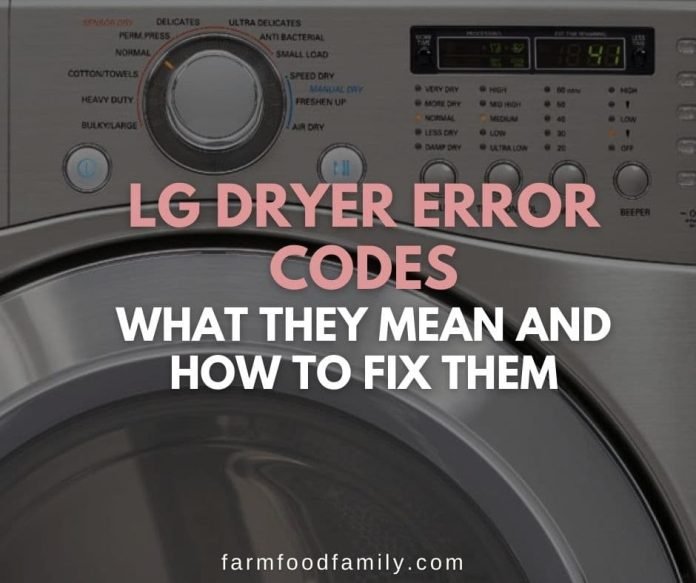
Having a dryer that works efficiently is crucial not only for convenience but also for energy conservation and garment care. Nobody wants to deal with unevenly dried clothes or skyrocketing utility bills. Understanding the causes of the E3 error and how you can prevent it is key to maintaining your dryer and extending its life. Let’s dive into the strategies that will keep your LG dryer running smoothly.
Understanding the E3 Error Code
The E3 error code, in simple terms, is like your dryer’s way of saying, “I’m not feeling well.” More specifically, it’s an indicator that there might be something wrong with the temperature sensor or thermistor. This is the part of your dryer that measures the temperature inside the drum and ensures that your clothes are drying at the correct heat level. When this sensor isn’t functioning properly, it can result in overheating or under-heating, which in turn triggers the E3 error.
You might be wondering, “Why does this happen?” Well, much like how a clogged artery can affect blood flow, a malfunctioning temperature sensor disrupts the dryer’s ability to maintain a consistent temperature. This can occur due to a variety of reasons, such as a faulty thermistor, wiring issues, or even a problem with the control board. Sometimes, it’s simply a case of wear and tear or recurring power surges that upset your dryer’s delicate electronic balance.
So, what’s the big picture? It’s all about maintaining balance. Just as your body needs the right conditions to function optimally, so does your dryer. Ensuring that each component works in harmony will prevent future issues. Now, let’s explore how to maintain this balance.
Regular Maintenance and Cleaning
Here’s the deal: Regular maintenance is your first line of defense against the E3 error code. Think of your dryer like a car that needs routine oil changes and check-ups to run smoothly. The same goes for your home appliances. Cleaning your dryer regularly can prevent lint buildup, which is a common cause of overheating and other operational issues.
Start by removing and cleaning the lint filter after each use. This simple step is like giving your dryer a fresh breath of air. Just as dust can gather on surfaces at home if left unchecked, lint can accumulate and obstruct airflow, creating unnecessary strain on your dryer.
Next, consider a more thorough cleaning every few months or after heavy usage periods. This involves cleaning the exhaust vent and checking for any lint that might have bypassed the filter. Here’s a tip: Unplug your dryer and carefully vacuum the area around and inside the vent. This prevents any blockages that could lead to overheating or poor drying performance.
Regular check-ins and clean-ups can go a long way in maintaining dryer efficiency and preventing errors. As you make maintenance a routine, your dryer will thank you with smooth, hassle-free operation.
Monitoring Electrical Connections and Components
Now, let’s talk about the brain of your dryer—its electrical components. Imagine if you had loose connections in your brain; things wouldn’t function too well! That’s why ensuring tight, secure electrical connections within your dryer is essential to prevent the E3 error.
Start by inspecting the wiring connected to the temperature sensor. Over time, wires can become loose or corroded, much like how wear and tear might affect the plumbing in an older home. If you notice any damaged wires or loose connections, it’s crucial to address these immediately. If you’re not comfortable doing this yourself, enlisting a professional’s help is always a smart move.
Another point to consider is the health of your home’s electrical system. Power surges or fluctuations can affect your dryer’s electronics, causing them to malfunction. Using a surge protector or dedicated circuit for your dryer can act like a safety net, protecting against unexpected electrical issues.
By regularly monitoring these aspects, you ensure that your dryer’s internal systems are in tip-top shape, reducing the chance of encountering the E3 error. These small, preventative steps can save you time and hassle down the line.
Seeking Professional Assistance When Necessary
Sometimes, despite our best efforts, things don’t go according to plan—like when you’re following a recipe, but the cake still doesn’t rise. The same can happen with your dryer. If you’ve undertaken regular maintenance and checked the electrical components, but still encounter the E3 error, it might be time to call in the experts.
A professional repair service can diagnose issues that aren’t immediately visible. They have the tools and expertise to delve deeper into potential problems that might be unnoticed on a surface level. Professionals can also provide guidance on parts that may need replacement, like a worn-out thermistor or sensor, to prevent future errors.
Moreover, scheduling an annual check-up for your dryer is always a good practice. Think of it as a health screening for your appliance. It ensures that components like the motor, control board, and heating elements are functioning optimally.
Remember, preventing major issues by addressing minor ones early is always the best route. When your dryer runs like a well-oiled machine, you’ll appreciate the peace of mind knowing you’ve minimized the risk of unexpected errors.
In conclusion, preventing the LG dryer E3 error code involves a combination of regular maintenance, monitoring, and professional advice. By treating your dryer with the care and attention it deserves, you not only enhance its performance but also extend its lifespan, ensuring it remains a reliable part of your household for years to come.